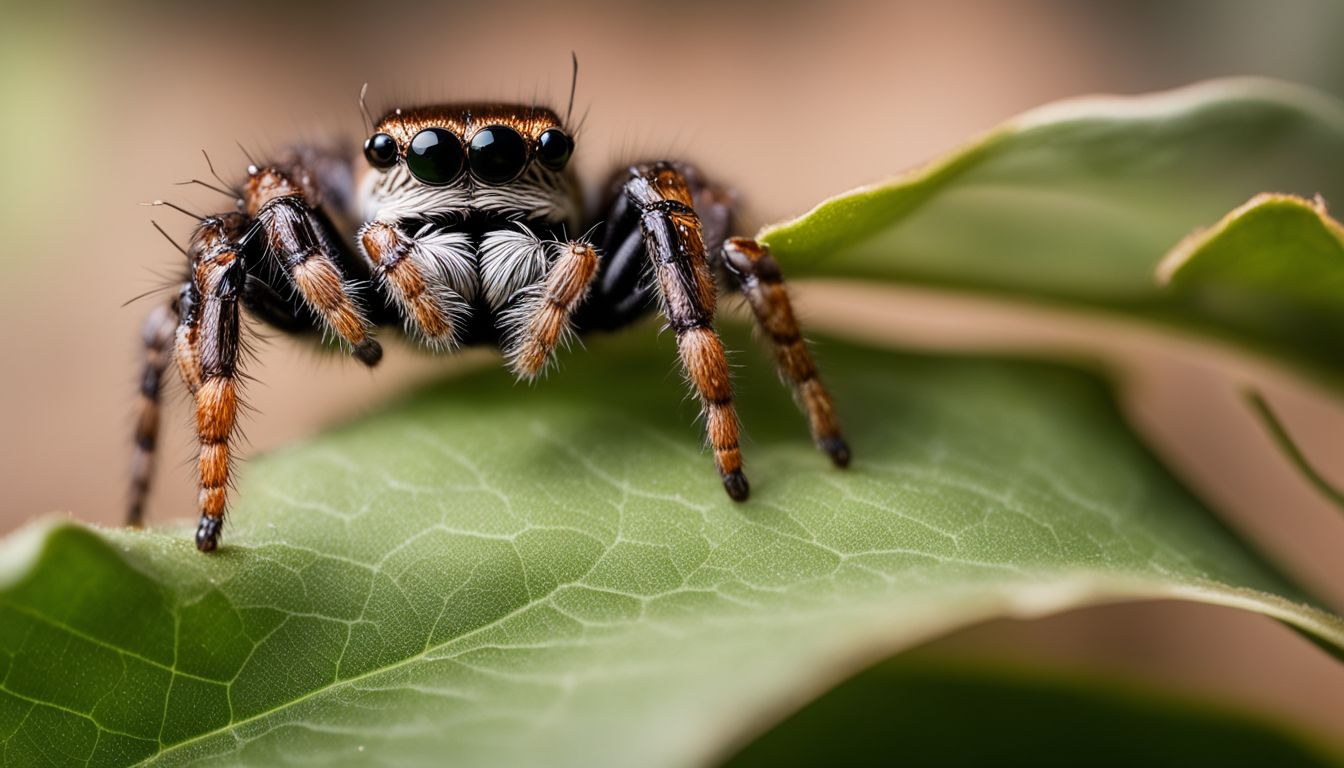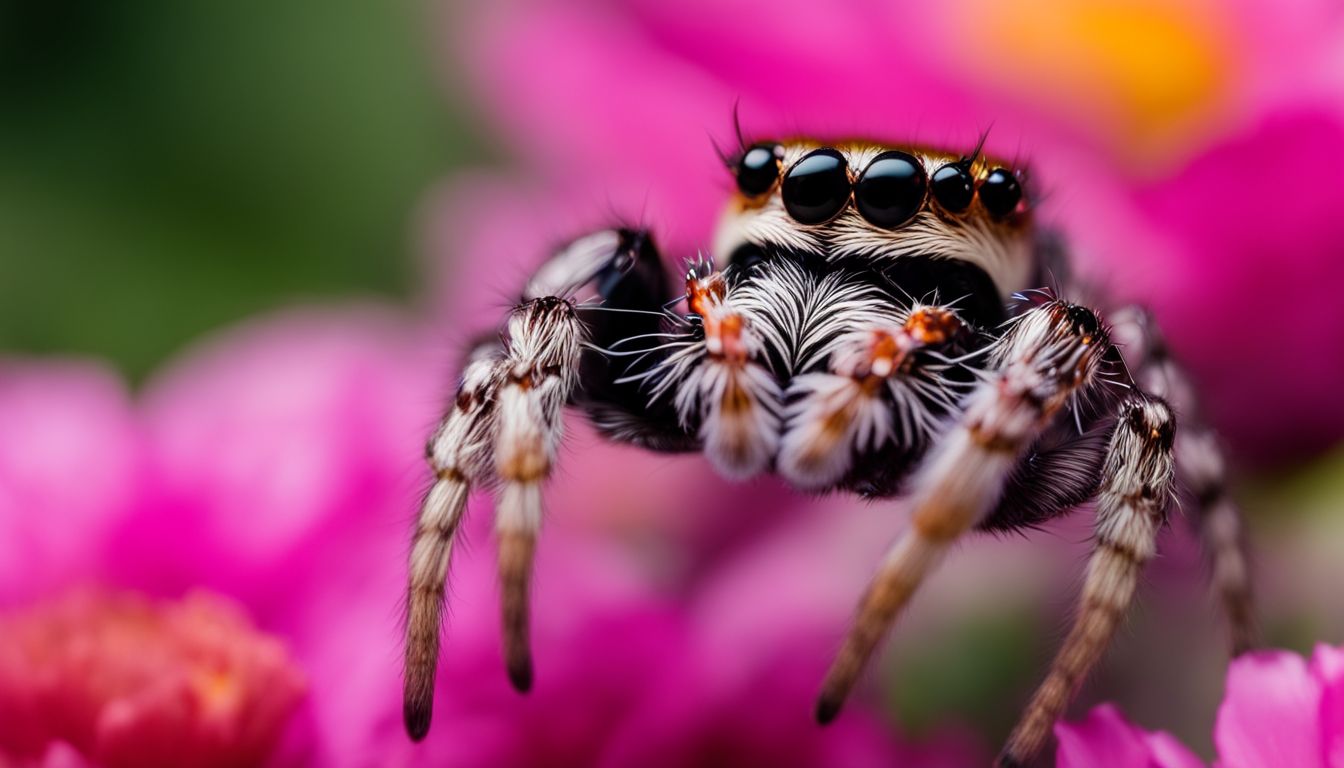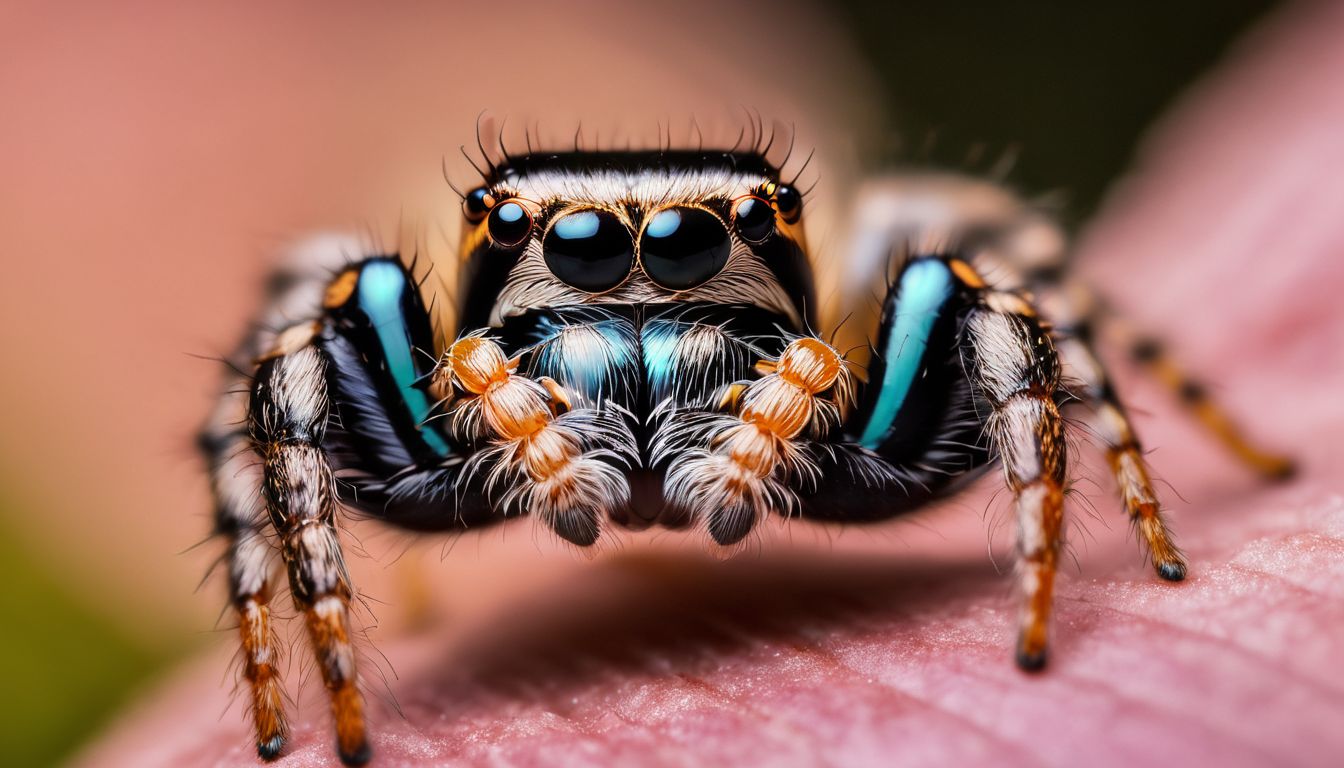Have you ever spotted a jumping spider and wondered if it snacks on ants? Despite their prowess as hunters, it’s not common for these spiders to make a meal of ants. Our guide dives into the details of what jumping spiders really feast on, giving you clarity on their dietary habits.
Keep reading to unravel the mysteries of these fascinating jumpers’ menus!
Key Takeaways
- Jumping spiders can eat ants occasionally, but it’s not their preferred food due to the risks associated with ant consumption.
- Their diet mainly consists of insects and arthropods such as crickets, fruit flies, and grasshoppers. Some species also consume nectar and pollen from flowers.
- In captivity, pet jumping spiders may have a more limited diet compared to those in the wild, affecting their feeding habits.
- They play a crucial role in the ecosystem by controlling pest populations through predation and contributing to pollination by consuming nectar.
Can Jumping Spiders Eat Ants??

Jumping spiders can occasionally eat ants, but there are potential risks associated with consuming them. Let’s explore their diet and prey preferences in more detail.
The occasional ant in the diet of jumping spiders
Some jumping spiders may snack on ants from time to time. Ants are not the top food choice for these spiders, but they might eat them if other bugs are hard to find. Eating ants can be risky for these spiders because ants have strong bites, stingers, and chemicals like formic acid that can hurt or kill the spider.
However, there is a special kind of jumping spider that likes eating ants more than others. These ant-mimic spiders look a lot like ants themselves. This trick helps them get close to the ants without scaring them off.
But most jumping spiders stay away from eating lots of ants since it can be dangerous for them.
The potential risks of ants to jumping spiders
Ants can be very dangerous for jumping spiders. They have strong bites and often work as a team to fight threats. Their venom can hurt or even kill a small spider. Most ants are also very fast and alert, which makes them hard for jumping spiders to catch without getting hurt.
Because of these risks, many jumping spiders avoid eating ants if they can find other food like flies or beetles. This means that in the wild, you will mostly see them hunting different kinds of bugs that don’t fight back as much.
Now, let’s look at what these amazing jumpers prefer to munch on when they have the choice.
What Do Jumping Spiders Typically Eat?

Jumping spiders typically eat insects and arthropods such as crickets, fruit flies, and grasshoppers. They may also consume nectar and pollen from flowers, showcasing their omnivorous diet.
Preferred prey: insects and arthropods
Jumping spiders love to chase down and eat many types of tiny bugs. Insects and other small creatures like flies, aphids, grasshoppers, and even other spiders are on their menu. They have sharp eyes that help them spot their next meal from far away.
Then they leap quickly to catch it! This makes them great hunters who control pests by eating insects that might harm plants.
Spiders in this group don’t spin webs to trap food like some other spiders do. Instead, they use their speed and jumping skills as weapons against prey the same size or smaller than themselves.
They enjoy a variety of tasty bugs, which provides them with the energy they need to keep hopping around.
Next up: How these amazing spiders take sips of nectar and munch on pollen too!
The consumption of nectar and pollen
Jumping spiders don’t just eat insects. Some of them also enjoy sipping nectar from flowers and plants, which provides them with extra nutrients. Spiders like those from the Myrmarachne genus have been spotted feasting on nectar and pollen to round out their diet.
This means that these spiders aren’t only meat-eaters; they also consume plant products to stay healthy and strong.
Understanding what jumping spiders eat helps us see how they fit into their ecosystems. Now let’s delve into their interactions with other insects, particularly bees, for a broader picture of their diet and behavior in the wild.
Interaction with other insects: Do Spiders Eat Bees??
Jumping spiders not only consume nectar and pollen but are also skilled at catching various insects. These include flies, moths, crickets, and even bees. While many jumping spiders have been observed preying on bees in the wild, they might avoid toxic prey when offered to them in controlled settings.
This shows their ability to learn and adapt to different situations when it comes to interacting with bees or any other potential prey, showcasing their diverse predatory behavior.
The Feeding Habits of Jumping Spiders in the Wild vs. as Pets
Jumping spiders in the wild have a varied diet that includes insects and arthropods, while pet jumping spiders are usually fed wax worms or fruit flies. Their feeding frequency also differs between natural habitats and captivity.
Dietary differences in natural habitats versus captivity
Jumping spiders in the wild have a wide variety of insects to choose from for their meals, such as mosquitoes, fire ants, and even frogs. They also eat plant food like nectar and pollen.
In captivity, pet jumping spiders may not have access to such a diverse menu and might rely more on feeder insects available to their owners. This limited diet could affect their eating habits compared to those living in their natural habitat.
Captured jumping spiders may miss out on some nutritious foods found naturally in the wild. It’s important for spider owners to provide a balanced diet that mimics what they would eat if they were still roaming free.
How often jumping spiders need to eat
In natural habitats, jumping spiders typically eat every three days or so, and they can even go without eating for a few weeks. Here’s a detailed look at their feeding habits:
- Jumping spiders have a varied diet that includes insects, arthropods, and occasionally nectar and plant fluids.
- They are skilled hunters and rely on their keen eyesight to catch prey.
- Spiders kept as pets also need to be fed regularly, approximately every three days, to maintain their health and energy levels.
- Feeding frequency may vary based on the specific species of jumping spider and their individual metabolic rates.
The Role of Jumping Spiders in the Ecosystem
Jumping spiders play a crucial role in the ecosystem by helping to control pest populations through predation. They also contribute to pollination through their consumption of nectar, making them an important part of the natural balance in their habitats.
Predation and pest control
Jumping spiders play a vital role in the ecosystem by helping to control pest populations. They are efficient predators, preying on insects like mosquitos and flies, contributing to natural pest management.
Their ability to mimic ants also helps them in hunting, enhancing their success in catching prey. Although they may occasionally eat ants, jumping spiders primarily target other insects and arthropods as their preferred prey due to their nutritional value.
Their presence not only helps keep pest numbers in check but also contributes positively to the balance of the ecosystem by reducing reliance on chemical pesticides.
Pollination through nectar feeding
Some jumping spiders have been seen drinking nectar from flowers. This suggests they might help in the pollination of plants. Research found that certain crab spiders can enhance flower pollination by feeding on nectar and leaving their leftovers on carnivorous plants, aiding both plant growth and spider diet diversity.
The inherent connection between jumping spiders and pollination reveals a fascinating aspect of these small creatures’ role in the ecosystem, going beyond predator-prey relationships to contributing positively to the environment.
Moving forward to “5. The Role of Jumping Spiders in the Ecosystem” section, let’s explore how these tiny predators play a vital part in nature’s balance.
Conclusion
In conclusion, while jumping spiders do eat ants occasionally, it’s not clear if they prefer them. Jumping spiders typically feed on insects and arthropods of similar size to themselves.
Their diet also includes nectar and pollen. Understanding the diverse diet of jumping spiders sheds light on their role in the ecosystem and their feeding habits in the wild versus captivity.
FAQs
1. What do jumping spiders usually eat?
Jumping spiders like Salticus scenicus, which are part of the Salticidae family, enjoy eating small bugs such as fly larvae and centipedes. They’re known to be hunters that catch a variety of prey.
2. Can pet jumping spiders eat ants?
Most pet jumping spiders should not eat ants because some ants, like weaver ants or red ants, have poison that can hurt the spider. It’s better to feed them safer prey.
3. Will baby jumping spiders eat the same food as adults?
Spiderlings, or baby jumping spiders, often eat smaller food than adult ones do. They might snack on tiny insects until they get big enough to tackle larger meals.
4. Are there any special kinds of jumping spiders that behave differently around ants?
Yes! The Bagheera kiplingi is one kind of jumping spider that acts a bit like an ant itself — this trick is called myrmecomorphy — and sometimes it eats plant stuff too!
5. Are all types of spiders able to eat ants safely?
No, not all kinds can! For instance, black widows and brown recluses—true spiders—might avoid certain tough or poisonous ants while others like tarantulas might handle them better due to their size and strength.




